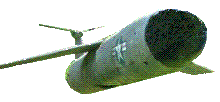|
Sembach AB
Hahn AB
Bitburg AB
Kadena AB
Osan AB
Tainan AB
Lowry AFB
Wheelus AB
Orlando AFB
Camp Happiness
Missile History I
Missile History II
Missile History III
The MM-1
Collectibles
Home Page
|
The Martin Matador and
Mace Missiles
Chapter Two
The "Spotter's Guide"
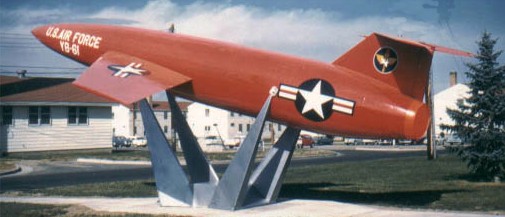 |
YB-61 Matador
Photo Courtesy of Bob Bolton
(olliesnapper@gmail.com)
|
|
"Attached to this message is a picture of the gate guard in front of the HQ training building in Denver...
... While I was in PATS (Personnel Awaiting Training Squadron) at Denver I had the dubious honor, at that time, of stripping the old paint off of this missile. It was in the process of being refurbished for the display condition you see in the picture. I worked in some bone yard near the flight line while stripping the paint off of the missile and stripping the skin off of my hands with the chemicals I used. I took this picture in May of 1961 a couple of months before I left Denver heading to Orlando.
In 1998 I submitted this same picture to the Association Of The Air Force Missileers "Victors in the Cold War" book and it was published in B&W on page 48".
Bob Bolton (olliesnapper@gmail.com)
|

U.S. Air Force Tactical Missiles
By the Editors of this Website!
|
Beyond the Web Page... The only book devoted exclusively to the Matador and Mace Tactical Missiles. The book reveals the story from the initial idea that became the first U.S. pilotless bomber, through the politically troubled development of the ever evolving deployment methods of the Matador and Mace Tactical Missiles. It covers the Units, Groups, Squadrons and Wing that fielded the missiles. From the United States test sites, Europe, Asia and North Africa nothing is omitted. All phases of the application of these two missiles by the U.S. Air Force (and West German Luftwaffe) are included, from the first tentative launches of the XSSM-A-1 Matador in January 1949, to the tense alert duty of the Cuban Missile Crisis, and the final launch of a MQM13A in May of 1977. The maintenance, logistics and launch, the men, equipment and tactics are all there.
|
|
"Bob, George, I finished your book 2 days after I received it. Couldn't put it down. It was incredible reading and incredibly detailed information."
Kent Washburn (KWASH55@aol.com) Mace B, Kadena, Okinawa
"George and Bob. I want you both to know how much I enjoyed reading and how much I admire and appreciate what you have accomplished in developing and publishing "The Pioneers". It is truly an outstanding piece of work, reflecting the time and effort required to produce it, but is also a formidable contribution to our military history. I mentioned in some earlier correspondence that I was a little disappointed in the relatively small amount of information regarding the Operating Location/Guidance Sites but you largely made up for it with this magnificent book."
Dale Lake (daleflake@yahoo.com) 601st Tactical Control Squadron, 38th TMW, Hamm, Germany
"I just finished your book, The Pioneers, et al. Please accept my "job well done!" Not only is it informative, but it's very readable. I'd also like to complement you on how well you footnoted it. You have shown that a scholarly work can be both instructive and enjoyable."
Michael Roof (lavinaschnur@hotmail.com) SGM USA (Ret.)
|
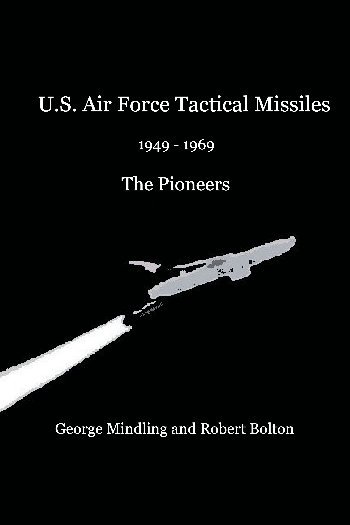
ISBN 978-0-557-00029-6
"Very good work with great detail."
Col. Charlie Simpson, USAF, Retired
Executive Director
Association of Air Force Missileers
"George, the book arrived on Tuesday while I was off to France. Of course, I quickly read the chapter about ´Germany's quiet step into the realm of nuclear armament.´ You know, this is still a widely ignored fact over here...
...For me it is fascinating to see what the picture really was in the 1950s and 1960s as opposed to what the official communication of the time wanted people to believe. A fascinating book shedding some light on the early days of tactical nuclear missiles as well as the political background that even today is still largely hidden behind the propaganda of the time. Can´t wait to read the rest of it."
Burkhard Domke
Harsefeld, Germany
|
"I have your excellent book on USAF tactical missiles. I actually witnessed the decommissioning of the Maces at Wüscheim back in 1966."
Paul Offen
Talitha, Tye Common Road
Billericay
Essex CM12 9PX
UK
"I just wanted to drop you a line and tell you how much I enjoyed the book that you and Bob wrote. The history was of particluar interest to me and my brother who was a history Professor at the University of Wisconsin. He also thought the book was well written, and he now knows what his little brother, (me), did while in Germany for three years."
George Joseph Snyder (gjsnyder@lanset.com)
71st TMS, Steinborn, Germany
"...by the way, I read your book, it was great, thanks for writing it."
Hack Hunton (hack@sstelco.com) Mace B, Kadena, Okinawa
|
|
US Air Force Tactical Missiles
©2008 - George Mindling and Robert Bolton |
|
Inspired by the 38th TMW Website, George Mindling and Robert Bolton co-authored US Air Force Tactical Missiles 1949 - 1969: The Pioneers ©2008, the story of America's first operational missiles, from the Matador to the Mace, from Taiwan, Korea, and Okinawa to Germany, including Lowry, Orlando, Holloman, Santa Rosa Island at Eglin, and even Camp Happiness!
|
|
Dieses Buch ist ein Muss für alle, die im Rahmen ihres Dienstes bei der U.S. Air Force mit den frühen Marschflugkörpern
zu tun hatten, aber auch für deutsche Militärarchäologen, die in der Eifel, im Hunsrück oder im Pfälzer Wald schon
über rätselhafte Hinterlassenschaften gestolpert sind. Nach mehr als 40 Jahren wird endlich eine Fälle von Fakten,
Informationen und Geschichten zu den zwischen 1954 und 1969 in Deutschland stationierten, mit Automwaffen ausgerüsteten
amerikanischen Matador und Mace auf den Tisch gelegt.
Ausfährlich und lebendig erzählen George Mindling und Bob Bolton von den jungen Missilemen, die im März 1954 erstmals in Bitburg ankamen -
noch ganz grün im Gesicht, weil auf dem Atlantik schwerer Sturm geherrscht hatte. Von den T-33-Flugzeugen, die aus übungsgründen so taten, als
wären sie Matador-Flugkörper, äber die Startstellungen hinweg in Richtung deutsch-deutsche Grenze donnerten und sich von der Gegenseite
nur nicht erwischen lassen durften. Oder von der Kuba-Krise, als die US Air Force Europe auf DEFCON 3 ging und an die Mechaniker in
Bitburg Munition für ihre Karabiner ausgegeben wurde.
Augenzeugen sagen dazu: "Wir hätten die Vögel auf jeden Fall innerhalb von 15 Minuten in der Luft
haben müssen!" Es ist lebendige Militärgeschichte, die nun nicht der Vergessenheit anheimfällt, sondern
jedermann zugänglich wird - auch für die ortsansässige Bevökerung, die heute endlich erführt, was sich damals
in ihrer Nachbarschaft zugetragen hat. Den beiden Autoren gebührt der Dank.
Klaus Stark (klaus_stark@t-online.de)
Berlin, Germany
This book is not only a must for all those who served in the U.S. Air Force with the early cruise missiles, but also for German military archeologists who have been puzzling over relics stumbled across in the Eifel, the Hunsrück and the Palatinate Forests. After more than 40 years, we finally have a wealth of facts, information and stories, from 1954 to 1969, of the nuclear equipped American Matador and Mace missiles stationed in Germany placed on the table.
With detailed and vivid descriptions, George Mindling and Bob Bolton talk about the young Missilemen who arrived for the first time in March, 1954, in Bitburg - still green in the face, having prevailed the Atlantic crossing in major storm. Of the T-33 aircraft which practiced as if they Matador missiles launched in the direction of German-German border, or from the Cuban missile crisis, when the U.S. Air Force Europe went on DEFCON 3 and was issued ammunition to the mechanics in Bitburg for their rifles. Eyewitnesses say: "We would have to have the birds in the air in any event within 15 minutes!"
It is vital military history that is prey to oblivion, but is now accessible to everyone - even for the local population, which today finally learns what happened at that time in their neighborhood.
The two authors deserve thanks for saving the history.
Klaus Stark,
klaus_stark@t-online.de
Berlin, Germany
|
|

|
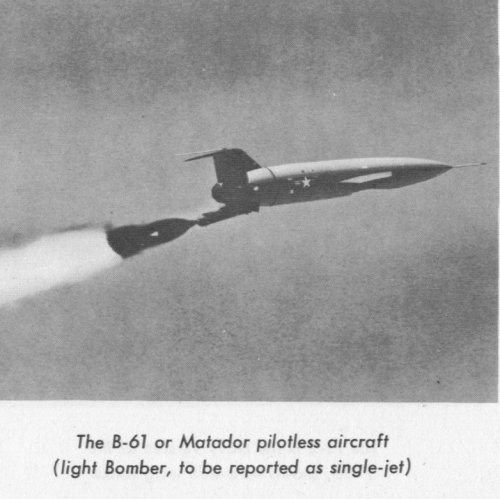
AF Manual 355-10 Aircraft Recognition for the Ground Observer - April 1955
|
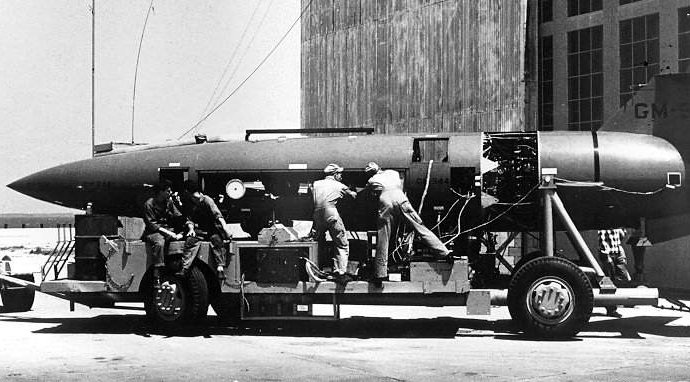
A YB-61 being readied for launch.
USAF/Glenn L. Martin photo.
|
|

A YB-61 Prototype heads for the fringes of outer space in this artists conception of a guided missile's flight. This full page Martin Aircraft ad commemorating the first ever use of the newly opened Atlantic Tracking Range by a Martin B-61 was one of two recently offered on E-bay.
Pretty high flying for an airbreather...
|

Nomenclature: A New class is Born
Starting it's illustrious history as the MX-771 Project in December 1945 as:
XSSM-A-1, becoming next the:
XB-61, (Experimental, Bomber, Pilotless)
YB-61, (Prototype, Bomber, Pilotless)
B-61, (Bomber, Pilotless)
TM-61A, (Tactical Missile)
TM-61B -(Tactical Missile) Not a production designation: changed to TM-76A Mace
TM-61C, (Tactical Missiles)
MGM-1C, (Mobile, Surface attack, Missile)
SPECIFICATIONS: TM-61C (MGM-1C)
Length: 39 ft 7 in
Span: 28 ft 7 in.
Diameter: 4 ft 6 in.
Weight: 12,000 lbs. at launch
Armament: W-5
Sustain Engine: Allison J33-A37 of 4,600 lbs. thrust
Thiokol solid-propellant booster rocket of 55,000 lbs. thrust used for launch
PERFORMANCE:
Maximum speed: 650 mph./565 knots in level flight; supersonic in final dive
Range: 650 statute miles
Operating altitude: N/A
|
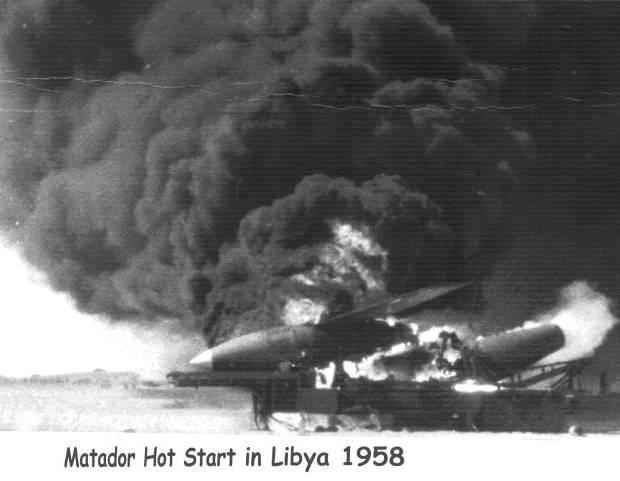
|
|
"I arrived at BAB about mid January 1956
and left about late November 1958. I was there when the missile burned in Tripoli. Some brave cowboy from armament roped the RATO bottle and dragged it off with a truck. When I first got
to BAB the squadron was the 1st Pilotless Bomber (or Aircraft) Squadron.
Malish flew back with our crew in 1958 and I was assigned to pet
and comfort him all of the way home. I'm writing up all of my experiences at BAB. When I
get through with it, I'll submit it to this web (TAC Missileer) page. It's
good to know that you all are here".
A/1C (tired) Paul A. Yadon,
(eatarn1@uswest.net)
|

The TM-61A and TM-61C models had a sharp, pointed nose cone. The TM-61s were originally guided by SHANICLE systems, made by Reeves, and later by MSQ-1 radio command guidance units.
|
Physical attributes..."The Dog House"
|
|
The original prototype Matador had a symmetrical tail pipe and aft fuselage section that apparently caused the missile to break up when it exceeded Mach .95 to Mach 1.15 during terminal dive. The Martin Company added an extension to the top of the fuselage called "the dog house" in a successful attempt to correct the problem. Early TM-61A's had the round aft section, but almost all TM-61Cs and the early TM-76As had the dog house, which actually added a flat, vertical panel directly above the tailpipe.
The fuselage "doghouse" was dropped on later production TM-76A and all TM-76B
missiles after the Martin Company added two hundred pounds of structural reinforcing to the wings and vertical fin. The fuselage tapered to the tail pipe equally all the way around on both later missiles.
The Matador was sustain powered by The Allison J33-A37 engine while the J33-A41, was used to sustain power the Mace.

Plastic Mace models of the era had the doghouse. |
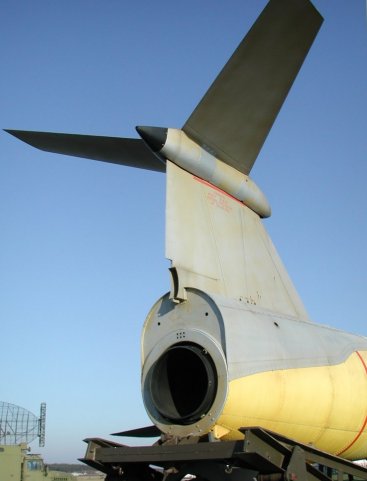
Burkhard Domke (burkhard@b-domke.de) photo
|
Richard Weigert (rweigert@PLASTEKGROUP.COM) commented on the doghouse being split in two halves vertically because of the vertical stabilizer mounting to the fuselage.
"The "A" model we had in tech school did have a smoke making modification. This was simply a fourth nitrogen charged accumulator filled with jet fuel that was sprayed into the engine exhaust. The other three accumulators supplied fuel to the engine during terminal dive."
|
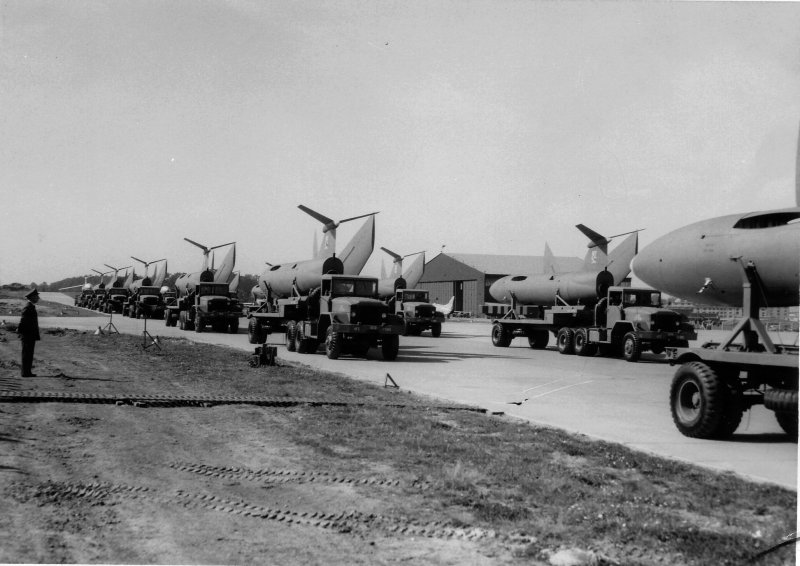 TM-61A Matadors during a ceremony at the 701st Tactical Missile Wing, Sembach Air Base, Germany 1956 USAF Photo courtesy of Henk Scharringa (henk.scharringa@gmail.com)
|
|
The Matador wing assembly had to be lifted off the airframe and trucked in a shipping brace alongside the fuselage or on a separate transporter. The special wing pivot and mounting assembly was designed for the Mace so the wings could be folded back and carried on the Translauncher ("A" Bird), or the launcher ("B" Bird) for quick assembly without the use of a crane.
The TM-61B Matador was introduced in early 1957, but the number and name were changed later in the year to the TM-76 A Mace. The development B-61B Matador had a curved radome nose, to accommodate the back to back mounted radar scanners, which moved the warhead to a new section of missile developed for the Mace. The Radar scanners dictated the use of the extreme nose as a mounting point, moving the warhead to a newly design and added fusleage piece that could be bolted right behind the new guidance package nose. The new warhead section bolted direcly onto the new fuel tank extension, which in turn bolted directly to the fuselage. A smart, economical way to build a reliable missile. This change, however, has caused identification and labeling problems even to this day.
|
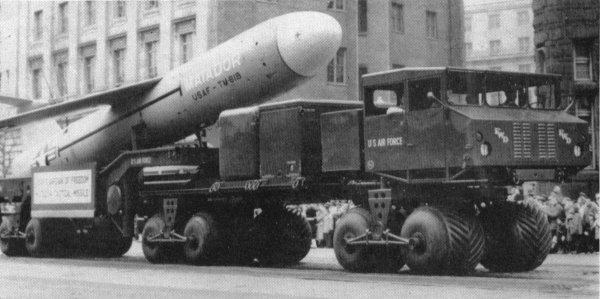 |
January 21st, 1957 - The debut of the US Air Force TM-61B Matador and the MM-1 Teracruzer occurred during President Eisenhower's 2nd Inaugural Parade in Washington D.C.
|
|
Photo from the Jan - Feb 1957 issue of FWD News reprinted with permission by FWD/Seagrave
|
|
Confusion over the missile numbering and naming system has earmarked the Mace program from the beginning. The differences between the TM-61B and the other versions of the Matador, the "A" and the "C", and the deployment method differences between them required a new designation for the TM-61B. The TM-61B Matador was renumbered and renamed to the TM-76A Mace. The TM-76"A" designation was used to denote the ATRAN guided version of the Mace as opposed to the difference of a second, inertially guided hard site launch version TM-76"B", already under design.
The TM-61A and C Matadors were deployed in Germany, Korea and
Taiwan
|
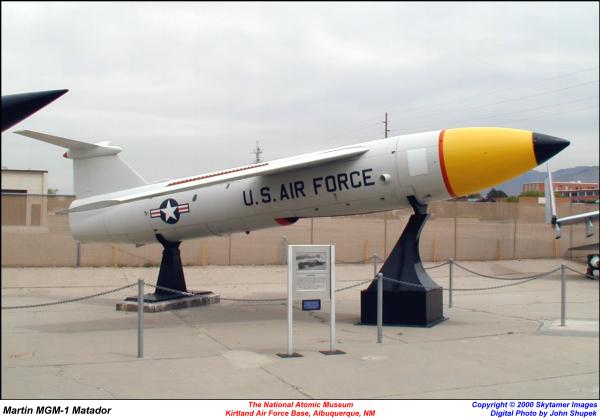
TM-61C Matador on display at Kirtland AFB, New Mexico
Photo used by permission of John Shupek, Skytamer Images
|
|
Below: The newly renumbered TM-76A on the Translauncher.
|
| 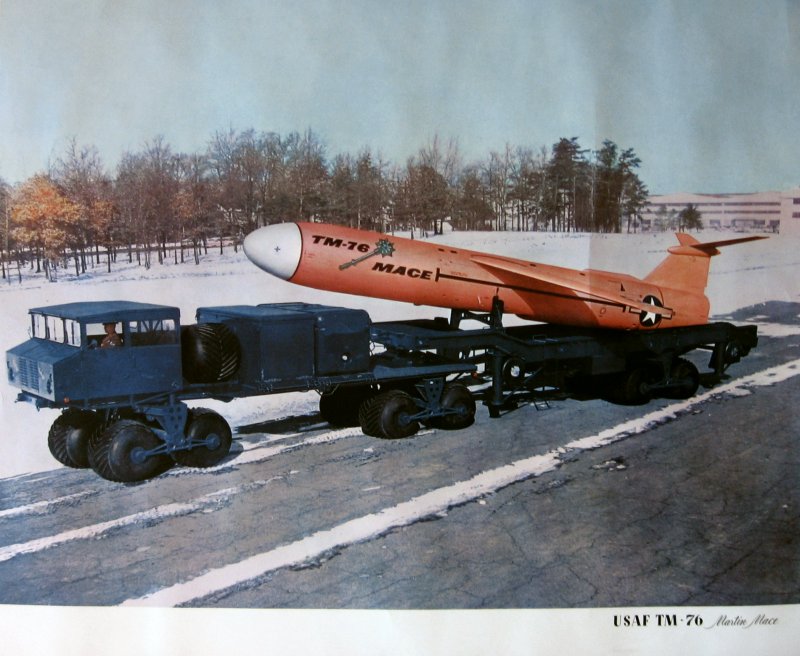 |
|
While going through some of my family heirlooms, I found some old posters that my dad had received in the late 50's or early 60's when he was an engineer with Bendix. They show a Matador launching, a Mace in orange paint on a MM1 and a Vanguard launching. I found your site while looking for information about them. I don't know any details about them but I did want to share the images with you and other interested people. Keep up the good work and thank you for your service.
Alan Meade (almede@verizon.net) |

The Mace

TM-61B/TM-76A Profile. The "Doghouse", or aft fuselage fairing was removed on later TM-76A (MGM-13A) and TM-76B (CGM-13B) missiles |
|
The major difference between the Matador and Mace missiles was the fact that both Mace "A" and "B" missiles were "Fire and Forget" weapons. All versions of the Matador were Command Guidance missiles, all Mace were Preset Guidance Units. There was no additional involvement once the Mace missiles were launched. The USAF MSQ guidance vans required for the USAF Matador guidance were removed from the German countryside after September 1962 when the last Matador operational units were deactivated.
Both Mace models had a rounded nose cone, with both versions having a longer fuel
cell forward of the wing extending the fuselage considerably over the Matador. The high shoulder mounted anhedral, or cathedral (anti-dihedral) wing with the "T" tail were easily recognizable features of both missiles, the Mace having a shorter wing span of only 22 feet and a longer length of 44 feet, 6 inches.
The "A" bird was primarily a "hug the ground" low level attack missile, using ATRAN (Goodyear's Automatic Terrain Recognition And Navigation map-matching radar system) while the "B" bird was designed to fly at very high altitudes for most of it's mission using unjammable inertial guidance, the AChiever system from AC Spark Plugs. The "A" Bird's mission survivability was considered quite high as intercepting the missile at speeds just below Mach 1 at altitudes considered dangerous for manned flight, especially in Europe's famous inclement weather, was beyond the air defense capabilities of the eastern block countries. The altered mission characteristics of the Mace "B" enabled almost doubling of the range of the "B" over the "A" without additional fuel capability from 650 to over 1200 nautical miles.
The wings folded back alongside the fuselage of the Mace for transport, rather than
having to be removed completely as with the Matador.
Both Mace versions were fitted for the
Mark 28 Thermonuclear Device
|
SPECIFICATIONS: TM-76A (MGM-13A)
Span: 22 ft. 11 in.
Length: 44 ft. 6 in.
Height: 9 ft. 7 in.
Weight: 18,000 lbs. at launch
Armament: Mark 28
Sustain Engine: Allison J33-A41 of 5,200 lbs. thrust;
Thiokol solid-propellant booster rocket of 100,000 lbs. thrust used for launch
Cost: $452,000
PERFORMANCE:
Maximum speed: 650 mph./565 knots in level flight; supersonic in final dive
Range: 800 statute miles
Operating altitude: N/A
|
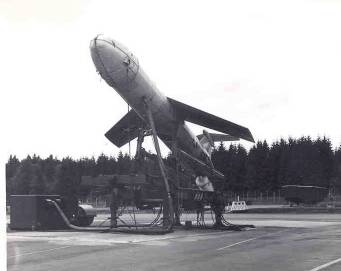
|
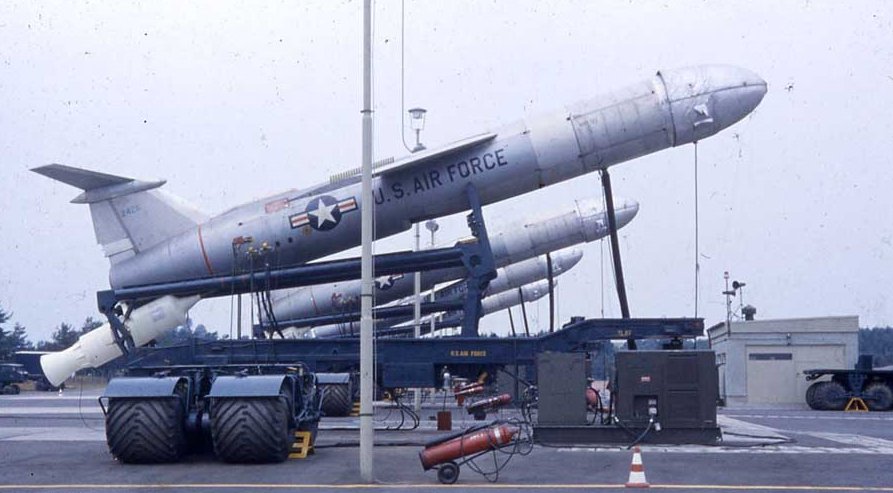
TM-76A Mace missiles on alert with the 405th Tactical Missile Squadron, Hahn Air Base, Germany
|
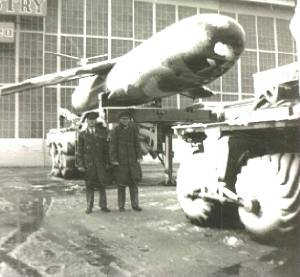
The "A" Birds were fired from mobile transporters called translaunchers. The huge terracruzer tire assemblies could be swivelled out of the way allowing the launcher to sit on jack pads. The original design was to fire individual missiles directly from the launcher.
That style of deployment was replaced in the early 1960's by Rapid Fire Multiple Lauch,
RFML, which concentrated launch pads in multiples of 4 missiles.
RFML allowed fewer crew members and far less set up time and effort. The "roving", single launcher concept was abandoned.
The "A" Birds had Goodyear's Automatic Terrain Recognition And Navigation
radar guidance system. The double, back to back nose mounted radar scanners
required the "A" birds have fiberglass nose cones, usually painted Olive
Drab while the rest of the bird was unpainted aluminum. Fiberglass nose cones that were not airworthy were painted red to indicate they were not to be mounted on operational missiles.
Mace missiles found in civic and public parks have had their nose cones painted red, black or white.
The last two years of Martin Marietta Mace production, 1959 and 1960, were all "B" versions
|

A TM-76A on a Translauncher is unloaded from a C-124 Globemaster
Photo by Glenn L. Martin Co |
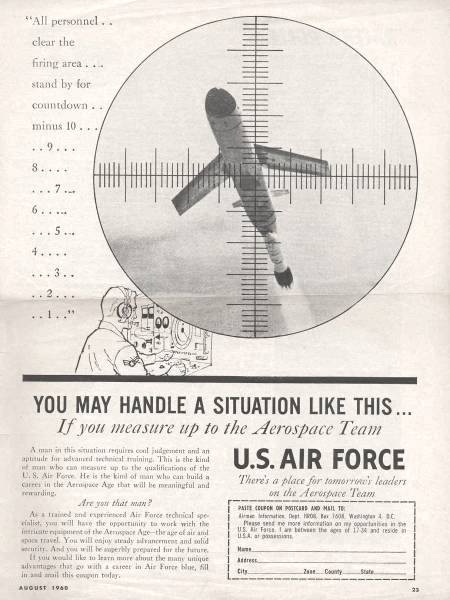
Hot Rod Magazine, August, 1960, clipping courtesy
of Dave Johnston, (fordman@eagnet.com)
|

|
SPECIFICATIONS: TM-76B (CGM-13B)
Span: 22 ft. 11 in.
Length: 44 ft. 6 in.
Height: 9 ft. 7 in.
Weight: 18,000 lbs. at launch
Armament: Mark 28
Sustain Engine: Allison J33-A41 of 5,200 lbs. thrust;
Thiokol solid-propellant booster rocket of 100,000 lbs. thrust used for launch
Cost: $452,000
PERFORMANCE:
Maximum speed: 650 mph./565 knots in level flight; supersonic in final dive (Final ballistic dive was accomplished by severing the wings with primacord and locking the horizontal stabilizer)
Range: 1,400 statute miles/1,217 nautical miles
Operating altitude: From less than 1,000 ft. to 40,000 ft.
|
|
The "B" version of the Mace was designed to be launched from complexes that consisted of 4 launch bays to a Launch Command Center. The Bitburg Launch complexes at Rittersdorf and Idenheim had two LCCs each, as did the four complexes at Kadena, Okinawa.
|
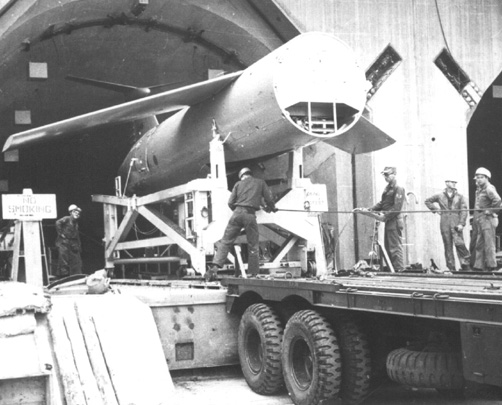 The operational "B" Birds were "cradled" in
hardened launch sites that actually had "train track" type rails mounted at a 15 degree angle on a torsion bar suspended floor system in each launch bay. The missiles themselves were mounted on dolly style launchers with matching railroad type hard steel type wheels which allowed the launcher to be rolled into the launch bay from the lowered launch door. The missile was moved to the launch door from the transport truck bed which also had matching rails mounted on it. All the maintenance bays also had the rails mounted on the hangar floors. The missiles were lowered and raised from the launch and maintenance bays by cable and power winch.
The launch bay had a huge torsion bar suspension system that
"went soft" at the first sign of nuclear attack, allowing the birds to remain
combat ready and immediately launchable.
The dolly style launcher sat on the
suspended cage, and actually dismantled on missile firing, with the missile actually flying through the collapsing launcher after the Thiokol RATO bottle was fired. Having explosive bolts (E-81's or 83's) in strategic locations that fired along with ignition of the RATO bottle accomplished the task of collapsing the launcher.
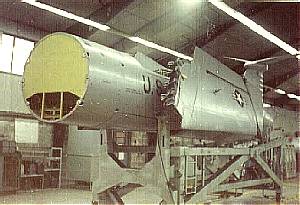
The "B" Birds had an Inertial Guidance System from AC Spark Plug. The stabilized platform (the guidance system) or as it was simply called the "gimbal" carried 5 gyros total: two were gyros and three rate accelerometers which had to be aligned with a theodolite that was on a surveyors mark to reference it for launch. The same theodolites were used in the maintenance areas for Guidance System Checkout.
The inertial guidance system dictated the use of the fixed hard sites for launch as it would have been impossible to reference the Gyro Stabilized Platform outdoors without surveying the launch location and the location of the referencing theodolite beforehand. The hardsite concept removed alignment process fom taking place outside in inclement weather or at night. "B" bird launches from TM-76A translaunchers at the Cape were done under controlled conditions using scaffolding that was not part of the operational concept.
The nose cone was aluminum and was the same color as the fuselage. The intricate web of wiring that surrounded the inside of the nose cone were piezio-electric contact fuses.
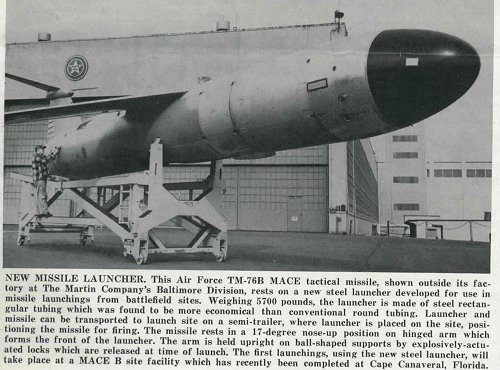
The missile in the clipping mounted on the "B" style launcher is actually an "A" model with the fibreglass nose cone on a "B" Bird hard site launcher. The missiles were otherwise almost identical. The "B" bird flight controls did not use a Directional Gyro as the "A" bird, using the Inertial Guidance system to fulfill that function instead, but both models used the Vertical Gyro.
Newspaper clipping from the Martin Company, 1960, courtesy of Bob Bolton (olliesnapper@gmail.com)
|
-Ready.jpg) |
An operational CGM-13B of the 498th Tactical Missile Group is prepared for launch countdown at Kadena Air Base, Okinawa, in 1969.
Photo courtesy of Dennis Cralley, Sr.(dcralleysr@cox.net)
|
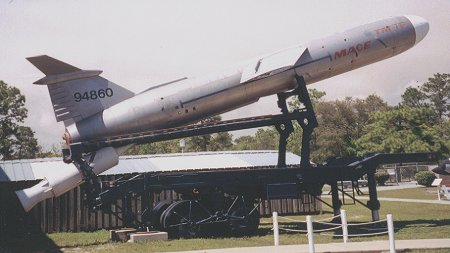
Photo coutesy of Bob Bolton (olliesnapper@gmail.com) |
TM-76B (CGM-13B) 59-4860 on display at the US Air Force Armament Museum near Eglin AFB, Florida, Summer, 1999
The nose cone is painted white instead of the natural aluminum of the operational "B" missiles and it is display mounted on an "A" Bird Translauncher, used to launch the first "B" birds at Cape Canaveral from open hard Pad 22 before the fixed hard sites 21-1 and 21-2 were completed.
A virtual tour of the Cape Canaveral facilities and the Mace Pads 21 and 22 is available at Rob Svirskas great page
|
Renaud Mangallon (renax@club-internet.fr) sent this photo and page for the TM-76B modeled directly after the TM-76B (CGM-13B) on display at the USAF Armament Museum at Eglin Air Force Base in Florida. Even the decal for the tail number (94860) is a perfect match.
Check the web page at http://renax.club.fr/sharkit/mace/mace.htm |
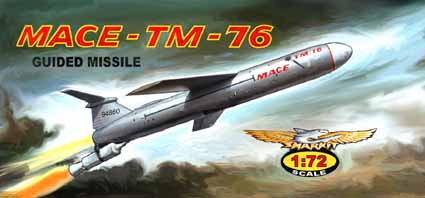
|
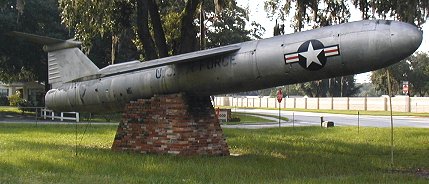
A CGM-13B Mace-B on display at the American Legion Post 18 in Wildwood, Florida, April, 2005. The Mace was assigned to the 4504th Missile Traing Wing, Orlando Air Force Base, until deactivated in 1966.
Photo by George Mindling myakka@embarqmail.com
|
|
The "Wildwood" Mace was relocated to the Indiana Military Museum in Vincennes, Indiana, in April, 2010, in a project spearheaded by the TAC Missileers Association.
A 30 minute video of the prepartion and dismantling of the CGM-13B can be found on the home page of the
TAC Missileers Association. Click on the video labeled "Mace Move Day"
The Mace display at the Indiana Military Museum in Vincennes, Indiana, is scheduled to open sometime in the near future.
|

|
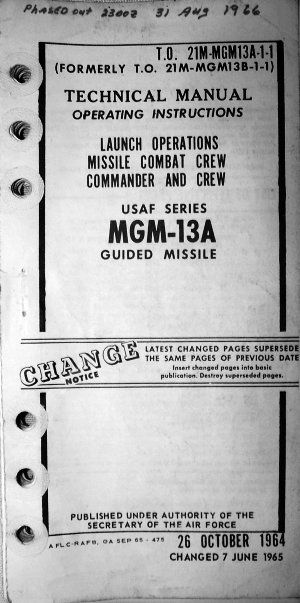 The Tactical Missile designation was changed to MGM-13A and CGM-13B to help
non-military personnel (such as members of Congress and the pentagon) identify
the type and purpose of U.S. weapons systems. The poorly explained logic at the time even
confused the Air Force, which incorrectly relabeled the "A" Birds as MGM-13B for a short time, and B birds as MGM-13C units, (see the numbering on the adjacent Launch Order TO). In the first attempt at correcting the error, the "B" Birds were relabled as CGM-13C before finally being labeled as the CGM-13B.
The Tactical Missile designation was changed to MGM-13A and CGM-13B to help
non-military personnel (such as members of Congress and the pentagon) identify
the type and purpose of U.S. weapons systems. The poorly explained logic at the time even
confused the Air Force, which incorrectly relabeled the "A" Birds as MGM-13B for a short time, and B birds as MGM-13C units, (see the numbering on the adjacent Launch Order TO). In the first attempt at correcting the error, the "B" Birds were relabled as CGM-13C before finally being labeled as the CGM-13B.
The "B" missiles at Bitburg were correctly renumbered when it was found
the MGM designation meant "mobile", which the "B" Bird clearly was not.
According to the January 1965 and 1966 DOD pub entitled "Model Designation of Military Aircraft Rockets & Guided Missiles", the three letter designations are broken down as:
Launch Environment Symbols
Mission Symbols
Vehicle Type Symbols
Using the pub tables provided for these categories in the case of the MGM the decoding would read (M)Mobile;(G)Surface Attack;(M)Missile while the CGM would decode as (C)Coffin;(G)Surface Attack;(M)Missile.
The "A" and "B" designations refer to the basic missile model, 13, which reflects the original TM-76A and TM-76B designations. The already deactivated TM-61A and TM-61C Matadors became MGM-1A and the MGM-1C, reflecting the 1st missile airframe used operationally by the US Air Force
Thanks to Bob Bolton (olliesnapper@gmail.com) for providing the information from the invaluable DOD manuals and the Block House Operating Technical Order (TO), the bible for the "A" Bird RFML launch crews.
|

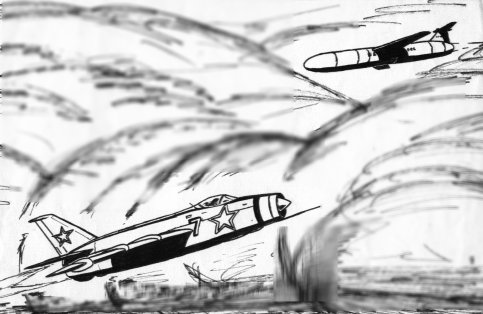
Original art work "Missed Intercept" by George Mindling - 1962 ©George Mindling
|

Two F-102 pilots from the 525th FIS, wearing
their flight suits and flight jackets, walked around the TM-76B mace on display during Open
House at Bitburg Air Base, Germany. They studied the wings and tail, pointing and gesturing.
After several minutes one turned and asked...
"How do you steer that thing?"
|
This page is in no way sponsored or endorsed by the United States Air Force.
Opinions and views expressed are those of the author and not necessarily those of the
Department of the Air Force.
|
Web Page Design and Development by
George Mindling - Port Charlotte, Florida
©George Mindling - 2003-2006 All Rights Reserved
|
|
